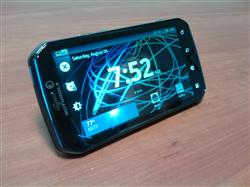
A smartphone is a mobile device that combines the functionality of a traditional mobile phone with advanced computing capabilities. It typically has a touchscreen interface, allowing users to access a wide range of applications and services, such as web browsing, email, and social media, as well as multimedia playback and streaming. Smartphones have built-in cameras, GPS navigation, and support for various communication methods, including voice calls, text messaging, and internet-based messaging apps.

IOIO is a series of open source PIC microcontroller-based boards that allow Android mobile applications to interact with external electronics. The device was invented by Ytai Ben-Tsvi in 2011, and was first manufactured by SparkFun Electronics. The name "IOIO" is inspired by the function of the device, which enables applications to receive external input ("I") and produce external output ("O").

The Motorola Cliq is an Android-based smartphone by Motorola.

The T-Mobile Pulse (sold as the CHT8000 in Taiwan) is an Android-powered phone manufactured by Huawei and rebranded by T-Mobile. It is available in many markets including the UK and The Netherlands. Compared to many Android phones released at the time it was relatively low cost - originally selling for £185 in the UK, the Pulse achieved a minimum price of £19.99 + £10 top up on PAYG before being discontinued in April 2011. This made it one of the cheapest Android powered smartphones available at the time. The Pulse was also marketed as being the first Pay As You Go phone running the Android OS.

The HTC Evo 4G is a smartphone developed by HTC Corporation and marketed as Sprint's flagship Android smartphone, running on its WiMAX network. The smartphone was launched on June 4, 2010. It was the first 4G enabled smartphone released in the United States.

A smartwatch is a portable and wearable computer device in a form of a watch; modern smartwatches provide a local touchscreen interface for daily use, while an associated smartphone app provides management and telemetry, such as long-term biomonitoring. While early models could perform basic tasks such as calculations, digital time telling, translations, and game-playing, smartwatches released since 2015 have more general functionality closer to smartphones, including mobile apps, a mobile operating system, and WiFi/Bluetooth connectivity. Some smartwatches function as portable media players, with FM radio and playback of digital audio and video files via a Bluetooth headset. Some models, called watch phones, have mobile cellular functionality such as making telephone calls.

The Motorola Droid Bionic is an Android-based, 4G LTE-capable smartphone designed by Motorola. It was originally scheduled for release in Q2 2011 but was delayed, eventually being released on 8 September 2011.
The HTC Evo Shift 4G is a smartphone developed by HTC Corporation and marketed as the concurrent/sequel to Sprint's flagship Android smartphone, running on its 4G WiMAX network. The smartphone launched on January 9, 2011.

The Motorola Photon 4G was a high end Android-based mobile smartphone that was distributed exclusively by Sprint. A very similar model was available as the Motorola Electrify from U.S. Cellular.

Recon Instruments was a Canadian technology company that produced smartglasses and wearable displays marketed by the company as "heads-up displays" for sports. Recon's products delivered live activity metrics, GPS maps, and notifications directly to the user's eye. Recon's first heads-up display offering was released commercially in October 2010, roughly a year and a half before Google introduced Google Glass.

Android Ice Cream Sandwich is the fourth major version of the Android mobile operating system developed by Google. Unveiled on October 19, 2011, Android 4.0 builds upon the significant changes made by the tablet-only release Android Honeycomb, in an effort to create a unified platform for both smartphones and tablets. The first phone with Android Ice Cream Sandwich was Samsung Galaxy Nexus.

The Sony Ericsson Xperia ray (ST18i) is an Android smartphone from Sony Ericsson. It was unveiled on 22 June 2011 in Singapore during CommunicAsia 2011. It was announced that the Xperia ray would be released globally in select countries from Q3 2011.

LG Optimus L5 is a slate smartphone designed and manufactured by LG Electronics. Optimus L5 is the mid-range handset in the L series, and it makes the transition to Android 4.0.

The Motorola RAZR i (XT890) is a smartphone designed by Motorola Mobility. It was officially announced on 18 September 2012 in London, UK.

The Samsung Galaxy S5 is an Android-based smartphone unveiled, produced, released and marketed by Samsung Electronics as part of the Samsung Galaxy S series. Unveiled on 24 February 2014 at Mobile World Congress in Barcelona, Spain, it was released on 11 April 2014 in 150 countries as the immediate successor to the Galaxy S4. As with the S4, the S5 is an evolution of the prior year's model, placing a particular emphasis on an improved build with a textured rear cover, IP67 certification for dust and water resistance, a more refined user experience, new security features such as a fingerprint reader and private mode, expanded health-related features including a built-in heart rate monitor, a USB 3.0 port, and an updated camera featuring speedy auto-focus through phase-detection. The video resolution has been upgraded to 2160p (4K) and the frame rate at 1080p has been doubled to 60 for a smooth appearance.
The Samsung Galaxy Pocket Neo is an Android smartphone manufactured by Samsung. It was announced in March 2013 and released in May 2013 as the successor to the Samsung Galaxy Pocket Plus. The handset is still budget-oriented, sporting a larger 3-inch display. Its specifications are similar to that of the Samsung Galaxy Pocket Plus, with only minor upgrades such as the Android 4.1.2 Jelly Bean operating system and the display size. The Samsung Galaxy Pocket Neo, like its predecessors, is still marketed as "Pocket Friendly," because it can be slipped inside pockets easily despite the larger size.

Wear OS is a version of Google's Android operating system designed for smartwatches and other wearables. By pairing with mobile phones running Android version 6.0 "Marshmallow" or newer, or iOS version 10.0 or newer with limited support from Google's pairing application, Wear OS integrates Google Assistant technology and mobile notifications into a smartwatch form factor. Wear OS is closed-source, in contrast to the free and open-source Android.

The Moto 360 is an Android Wear-based smartwatch announced by Motorola Mobility in 2014. It was announced on March 18, 2014 and was released on September 5, 2014 in the US along with new models of the Moto X and the Moto G.

The Phab 2 Pro is an Android smartphone in a phablet form factor, developed and produced by Lenovo and first released in November 2016 at an MSRP of US$499. The device is notable for being the first consumer smartphone to support Google Tango augmented reality (AR) technology.

Moto X4 is an Android smartphone developed by Motorola Mobility, a subsidiary of Lenovo. Unveiled on August 31, 2017, at IFA, it is a revival of the previously discontinued Moto X line. It was released in Europe at the end of September 2017.


















